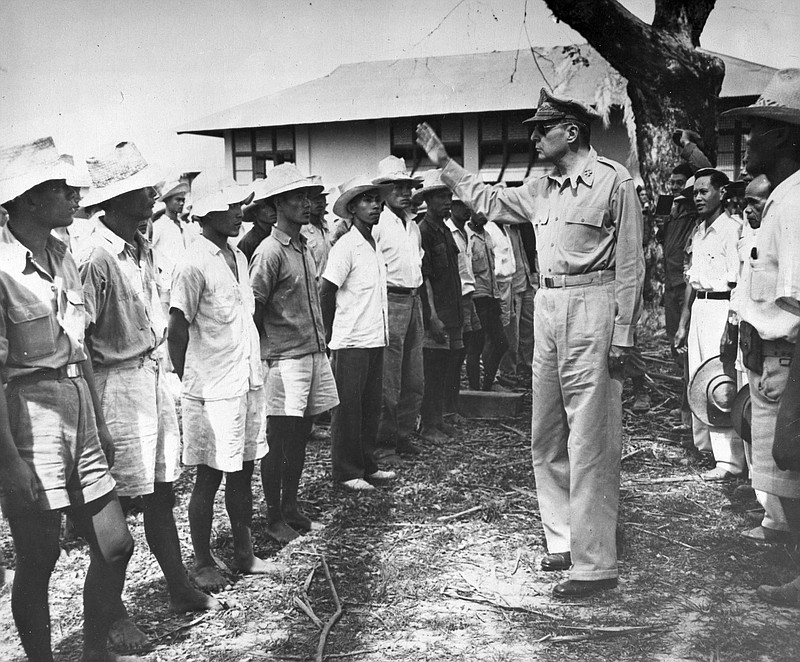"People of the Philippines, I have returned. By the grace of Almighty God our forces stand again on Philippine soil."
Gen. Douglas MacArthur delivered these words in a radio address shortly after wading ashore on Leyte Island on the afternoon of Oct. 20, 1944. Senior staff and Filipino officials-in-exile accompanied him through the knee-deep water. An iconic photograph captured the scene. U.S. Army forces had stormed ashore hours earlier and had established a secure beachhead. The extended campaign to liberate the Philippines from Japanese occupation was underway. Fighting intensified after the initial landings on Leyte.
Spain had ceded control of the islands to the U.S. at the conclusion of the Spanish-American War. Following years of opposition to U.S. rule, limited self-rule had been established in 1935. Full independence for the islands was scheduled for 1946. As war threatened, MacArthur assumed control of all U.S. and Filipino forces in late 1941.
Japanese aircraft attacked and neutralized U.S. air defenses on Dec. 8, 1941. Conflicting orders resulted in the destruction of most U.S. aircraft on the ground. A sequence of amphibious landings by Japanese forces began later that day. Suffering one defeat after another, U.S. forces slowly retreated to the Bataan Peninsula on Luzon Island. With no possibility for re-supply or reinforcements and defeat inevitable, President Roosevelt ordered MacArthur to depart on March 11, 1942. The general, his family and a handful of senior staff made a harrowing escape by PT boats, which took them to a U.S. air base for a flight to Australia. Upon reaching safety, the general pledged, "I came out at Bataan, and I shall return."
With little ammunition and facing overwhelming forces, U.S. and Filipino soldiers surrendered on April 9. The infamous Bataan Death March followed with an estimated 70,000 U.S. and Filipino prisoners forced to walk more than 60 miles to a rail head with little food or water, no medical care and unrestrained brutality from their captors.
About 14,000 Army, Navy and Marine personnel held out on Corregidor Island until May 6. The fortress off the southern tip of Bataan offered shelter in a network of tunnels. Food, water and medical supplies were soon exhausted. Japanese bombardment was incessant. Gen. Jonathan Wainwright surrendered all U.S. and Filipino forces on May 6. An estimated 23,000 American military personnel were killed or captured in the defense of the islands. Filipino casualties were five times higher. Sixty-eight Army and Navy nurses were taken prisoner.
Some of the prisoners would spend the war in camps in the islands. Others were transported by ships to work as slave labor in Japan. Some perished when these ships were torpedoed by U.S. submarines.
The campaign to liberate the Philippines was slow and costly due to difficult terrain, a well-entrenched enemy and widespread infectious diseases.
On Jan. 30, 1945, U.S. Rangers carried out a daring rescue of 552 Allied prisoners from a prison camp behind enemy lines. Intelligence indicated that the prisoners would be executed before Allied forces could reach the camp.
Manila, the capital city, was captured after a month-long battle on March 5, 1945. Fighting leveled the city. More than 100,000 civilians perished during the assault, many the victims of mass murders.
The Philippine campaign did not end until the surrender of Japan on Aug. 18, 1945.
U.S. forces suffered 16,000 deaths, 55,000 wounded, and more than 100,000 hospitalized with illnesses that included malaria and dysentery.
On July 4, 1946, the U.S. granted full independence to the Republic of the Philippines.
The numbers of men and women who served in our armed forces during World War II thin daily. We must never forget their courage and sacrifice.
Contact Clif Cleaveland at ccleaveland@atimesfreepress.com.
